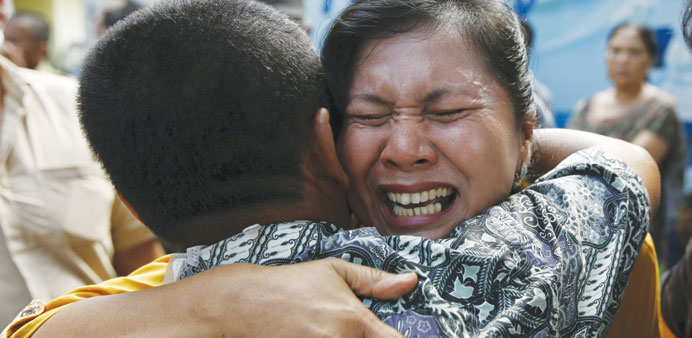AFP/Jakarta
The Indonesian military plane that crashed into a residential neighbourhood and killed 142 people likely suffered an engine failure, the air force said yesterday, but denied the aircraft was overloaded after claims civilians had paid to get on board.
The Hercules C-130 went down Tuesday in the city of Medan shortly after taking off from a nearby airbase, exploding in a fireball and causing widespread destruction.
Air vice marshal Agus Dwi Putranto, an air force operations commander, told reporters initial findings indicated the 51-year-old transport plane had failed to gain enough speed after one of its four engines malfunctioned.
“There’s a likelihood that a propeller had stalled,” he said. “Going at a slow speed, the plane swerved to the right and hit an antenna tower.”
He said the pilot had asked to turn back to base shortly after take-off, adding: “It means there was a problem.”
Witnesses have said the plane was tilting and giving off black smoke just before it crashed into a massage parlour and hotel in a newly-built residential area.
However Putranto denied the plane was overloaded after the air force repeatedly revised upwards the number of people on the flight, sparking accusations paying civilians were on board, in violation of military rules.
“It’s unlikely an overcapacity problem,” the commander said. He said that the Hercules could carry 12.5 tonnes but the passengers on the flight would have only weighed about eight tonnes.
There were 122 people aboard the plane, mostly servicemen and women and their families, with the rest of the fatalities thought to have occurred on the ground.
Relatives of some civilians from non-military families have said they paid between 700,000 rupiah ($50) and 1mn rupiah to travel on the aircraft. The military has denied taking payments and vowed to investigate.
Janson Halomoan Sinaga, who lost five relatives who had been heading to the remote Natuna islands, said his relatives had all paid, adding they were “not a military family”.
The plane set off from Jakarta and had made several stops before arriving in Medan, the largest city on Sumatra island with a population of around 2mn. It was due to head on the Bintan island, off Singapore, and then the Natuna islands.
The search for bodies has largely been called off with just a handful of soldiers and police left sifting through the rubble on Thursday, down from a search and rescue team of several hundred.
So far 63 bodies had been identified, said police medical official Arthur Tampi. But he added it would difficult to identify the rest of the victims visually, hinting at the damage they had suffered in the fiery crash.
Buildings were left severely damaged, cars reduced to flaming wrecks and the plane almost completely destroyed, with the mangled tail the only part still recognisable.
There have been emotional scenes at a hospital morgue in Medan as sobbing relatives gathered, with some breaking down as they discovered their loved ones in body bags.
The air force has begun transporting coffins containing victims’ bodies across the vast Indonesian archipelago with some of the first arriving at a Jakarta airport late Wednesday, where they were received with full military honours at a ceremony attended by President Joko Widodo.
It was the sixth fatal crash of an Indonesian air force plane in the past decade, according to the Aviation Safety Network, and prompted Widodo to order an overhaul of the country’s ageing military equipment.
Indonesia also has a poor civil aviation safety record -- the latest disaster came just six months after an AirAsia plane crashed into the Java Sea, killing all 162 people on board.
The brother of an Air Force member who was killed when a military plane crashed into Indonesia’s Medan city also died in a similar accident involving the same type of aircraft 24 years ago, local media reported yesterday.
Second corporal Saryanto, 38, was among 142 people who were killed.
His brother, second sergeant Sudiyono, died along with 134 others when another Hercules C-130 crashed into a neighbourhood in East Jakarta shortly after take-off on October 5, 1991.
“Since he was a little boy, Saryanto had always wanted to be an Air Force member, following the footsteps of his brother,” another brother, Suroso, was quoted as saying by Sindo.
“He saw his brother wearing the uniform and he wanted to wear it too,” Suroso said.
The death of Saryanto, the youngest in the family, came just four months after another tragedy, the death of his father.
Three crashes involving the Indonesian military’s C-130 aircraft have killed more than 370 people since 1991.

A woman after she found that her brother was among the victims.


